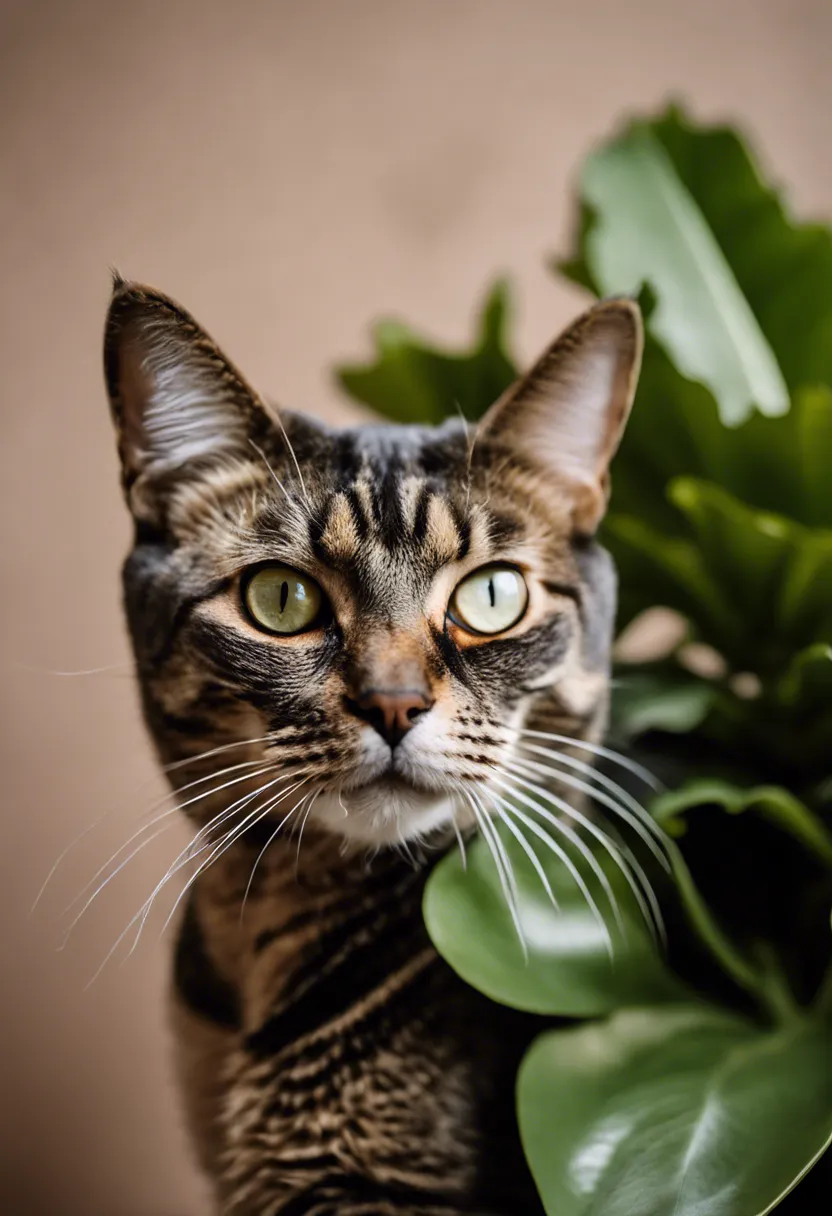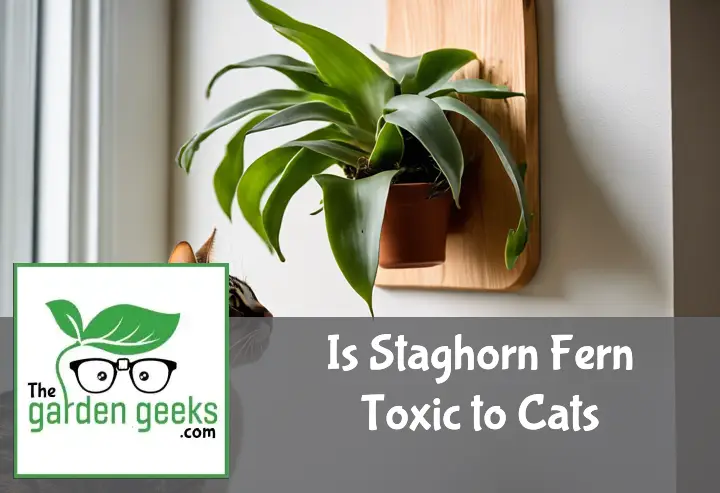Did you know that over 30% of American households own a cat? That’s millions of feline friends! Now, imagine the shock and worry when your beloved pet takes a nibble out of your favorite houseplant, the Staghorn Fern. Is the Staghorn Fern toxic to cats?
Cats are curious creatures by nature, often exploring their surroundings using their mouths. This can be a cause for concern when it comes to certain houseplants, as some may contain toxins harmful to our furry companions.
Keep reading about Staghorn Fern Toxic to Cats to find out more about this common houseplant and its potential effects on your feline friend. It’s always better to be safe than sorry when it comes to our pets’ health!
Quick Answer
- Staghorn Fern is not toxic to cats. Your feline friend can play around it without any worry.
- If your cat shows signs of distress like vomiting, diarrhea, or unusual behavior after interacting with a plant, it might have ingested something toxic. But it’s not the Staghorn Fern.
- To prevent any risks, keep all houseplants out of your cat’s reach. Not because of the Staghorn Fern but other plants could be harmful.
- If you suspect your cat has eaten a toxic plant, rush to the vet immediately. Don’t wait for symptoms to worsen.
- There are plenty of safe alternatives to Staghorn Fern for cat owners. You can still have a green home without risking your pet’s health.

Is Staghorn Fern Toxic to Cats?
Understanding the Staghorn Fern
The Staghorn Fern is a cool plant that looks like deer antlers. That’s why people love having it around their homes. It’s not just any old plant; it has a unique vibe that makes indoor gardens pop. Imagine having a piece of the jungle right in your living room! This fern doesn’t need soil to grow, which blows my mind. You can mount it on wood or hang it, making it super versatile for decorating.
Because of its easy-going nature and how awesome it looks, the Staghorn Fern has become a big hit among houseplant enthusiasts. It’s perfect for folks who want to add a green touch without too much fuss. Plus, its air-purifying qualities are a nice bonus.
Toxicity Profile of Common Houseplants
When we talk about plants and cats, things can get tricky. Some plants are like cat kryptonite – really bad news if your furry friend decides to take a nibble. But here’s where the Staghorn Fern stands out as a champ. Compared to other common houseplants that could send your cat to the vet, this fern is safe.
Many popular plants, like lilies and sago palms, are super toxic to cats. Eating even a little bit can cause serious health problems for them. But when it comes to the Staghorn Fern, you can breathe easy knowing your cat won’t end up sick from exploring this plant.
However, just because the Staghorn Fern isn’t toxic doesn’t mean your cat should make a salad out of it. Eating non-food items can still upset their stomachs or cause other issues. So, while this fern is safer than many others, keeping an eye on curious kitties is always smart.
In summary, compared to many houseplants with high toxicity levels that pose real dangers to cats upon ingestion, the Staghorn Fern offers peace of mind for pet owners looking for safe indoor gardening options.
Symptoms of Toxicity in Cats
When our furry friends nibble on something they shouldn’t, like a Staghorn Fern, it’s crucial to know the warning signs. Let’s dive into what to look out for.
Physical Signs to Watch For
Cats are curious creatures, but sometimes their curiosity can lead them into trouble. If your cat has gotten into a Staghorn Fern, you might notice some worrying cat physical symptoms. First off, if they start vomiting or have diarrhea, it’s a red flag. This is their body trying to get rid of something bad.
Another thing to keep an eye on is if they’re drooling more than usual or if there’s any swelling around their mouth or throat. These could be signs that they’ve eaten something toxic.
Breathing problems are also a big warning sign. If your cat is wheezing, coughing, or seems to have difficulty breathing, it means this is serious.
Lastly, pay attention to their skin and coat. If you see any rashes or notice their fur looks different, it could be a reaction to a toxic plant.
Behavioral Changes Indicating Distress
Cats are pretty good at hiding when they’re not feeling well, but there are some behavioral changes you can watch for. If your usually playful kitty is now lethargic and doesn’t want to move much, it’s a sign something’s up.
Another clue is if they’re hiding more than usual. Cats often hide when they’re in pain or scared because they feel vulnerable.
Changes in appetite can also tell you a lot. If your cat suddenly stops eating or seems unusually thirsty, it could mean they ingested something harmful.
Lastly, watch how they use the litter box. Any changes in bathroom habits might indicate health issues related to poisoning.
Remember, these signs can vary from cat to cat. The key is knowing your pet and noticing when something just isn’t right.



How to Prevent Toxicity in Cats from Houseplants


Keeping your furry friends safe from the green dangers lurking in pots and planters around your home doesn’t have to be a Herculean task. Here, we’ll dive into some simple yet effective ways to prevent toxicity in cats from houseplants. Because let’s face it, our curious feline companions can’t help but nibble on leaves that catch their eye, turning innocent exploration into a risky business.
-
Keep toxic plants out of reach: This might sound like a no-brainer, but you’d be surprised how many cat owners unknowingly place toxic plants within easy reach of their pets. Research your houseplants to ensure they’re safe for cats. If you own any that are harmful, consider moving them to high shelves or rooms that are off-limits to your kitty.
-
Use natural deterrents: Cats detest certain smells and tastes. Sprinkling cinnamon, rosemary, or vinegar around your plants can keep your cat at bay without harming the plant or the cat. These natural repellents are great for safeguarding your greenery while ensuring your cat stays healthy and happy.
-
Provide safe alternatives: Sometimes, cats chew on plants because they’re bored or lack sufficient greens in their diet. Offering cat-friendly grasses or herbs can divert their attention away from dangerous houseplants. Catnip or wheatgrass are excellent options that most cats love.
-
Train your cat: Yes, training is not just for dogs! You can teach your cat to stay away from certain areas or objects with consistent training and positive reinforcement. Use a firm “no” when they approach forbidden plants and reward them with treats when they obey.
-
Secure plants firmly: Cats are known for their curiosity and agility, which means they might accidentally knock over smaller pots during their explorations. Make sure your plants are in stable pots and placed securely where they cannot easily be tipped over by an adventurous feline.
By following these steps, you can create a safe indoor environment that both you and your cat can enjoy without worry.
What to Do If You Suspect Your Cat Has Ingested a Toxic Plant
If your furry friend has gotten into a plant you’re worried might be toxic, don’t panic. Here’s a straightforward guide on what steps to take next. Acting quickly can make all the difference.
-
Identify the plant. First things first, figure out exactly what your cat has eaten. If you can, take a piece of the plant with you for identification purposes. Knowing the specific plant can help the vet determine the best course of action.
-
Observe your cat for symptoms. Look out for signs of poisoning which may include vomiting, diarrhea, drooling, lethargy, or anything else that’s not normal for your kitty.
-
Call your veterinarian immediately. Time is crucial in these situations. Even if it’s after hours, call the emergency number or head to an animal emergency hospital right away.
-
Follow professional advice. Your vet might instruct you to do something at home before coming in or tell you to rush over immediately. Listen carefully and do exactly as they say.
-
Prevent future incidents by making sure toxic plants are out of reach or better yet, not in your home at all. Consider investing in cat-friendly plants that can satisfy their curiosity without risking their health.
Safe Alternatives to Staghorn Fern for Cat Owners
| Plant Name | Toxicity Level | Additional Benefits |
|---|---|---|
| Spider Plant | Non-Toxic to Cats | Air Purifying |
| Areca Palm | Non-Toxic to Cats | Improves Humidity |
| Boston Fern | Non-Toxic to Cats | Air Purifying |
| Swedish Ivy | Non-Toxic to Cats | Easy to Grow |
| Bamboo Palm | Non-Toxic to Cats | Removes Toxins from Air |
| Barberton Daisy | Non-Toxic to Cats | Produces Oxygen at Night |
| Blue Echeveria | Non-Toxic to Cats | Drought Tolerant |
| Wax Plant | Non-Toxic to Cats | Blooms Fragrant Flowers |
| African Violet | Non-Toxic to Cats | Blooms Beautiful Flowers |
To Wrap Up
So, we’ve learned a lot about whether the Staghorn Fern is toxic to cats. Good news – it’s not! Your furry friend can safely play around this plant without any worry of getting sick.
But remember, while Staghorn Ferns are safe, not all plants are. Always double-check before bringing a new plant into your cat’s space.
Lastly, if you ever suspect your cat has eaten something toxic, don’t wait. Contact your vet right away. It’s better to be safe than sorry!


FAQs about ‘Is Staghorn Fern Toxic to Cats?’.
What other houseplants are toxic to cats?
Many common houseplants can be toxic to cats including lilies, azaleas, and English ivy. Always research a plant’s toxicity before bringing it into your home with pets.
Can cats have allergic reactions to non-toxic plants?
Yes, even non-toxic plants can cause allergic reactions in some cats. Symptoms may include sneezing, itching, or skin rashes. Always monitor your cat after introducing new plants.
Are there any signs that my cat has ingested a toxic plant?
Signs of toxicity in cats can include vomiting, diarrhea, drooling excessively, loss of appetite and lethargy. If you notice these symptoms, contact your vet immediately.
How can I discourage my cat from eating houseplants?
You can discourage your cat from eating houseplants by providing them with safe alternatives like cat grass or by using pet-safe deterrent sprays on the plants.
What should I do if I’m unsure whether a plant is safe for my cat?
If you’re unsure whether a plant is safe for your cat, it’s best to err on the side of caution and not bring it into your home until you’ve researched its safety.
What are some safe alternatives to Staghorn Fern for cat owners?
Safe alternatives for cat owners include spider plants, Boston ferns and Swedish ivy. These plants are non-toxic and generally well-tolerated by cats.
How quickly should I react if I suspect my cat has ingested a toxic plant?
You should react immediately if you suspect your cat has ingested a toxic plant. Contact your vet or an animal poison control center right away as timing could be critical.


